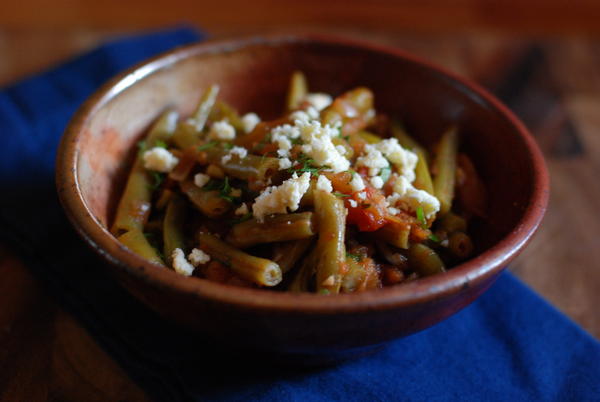Well, London may have the edge when it comes to strawberries, but DC is just bursting with amazing fruits and vegetables this time of year. And I'm going to go out on a limb and say that eating that summer produce is way, way more fun when your A/C works. Because since May, ours hasn't. And now it does. And cold air, it is wonderful. (In other news: if you've come over to our house in the last couple months and been inexplicably hot, sorry about that.)
Now that we're no longer hot from the moment we wake up in the morning, I can bear a trip down to the Sunday market. This past Sunday, I picked up some bright red, plump sour cherries, two pounds of rhubarb (for recipes I'll be telling you about soon), and some lovely baby zucchini.
Baby zucchini is so, so pretty, no? All those different shapes and sizes? The little skinny sticks and the bigger, round patty pans? How can you not love them?
And yet, as is the case every year, I bring home a basket of those zucchini, and they sit. In the fridge. For days. Because people, I don't ever know what to do with them. They don't taste different than big zucchini, they just look different. So I feel like I have to leave them whole to preserve their cuteness. Otherwise, why not just buy the regular ones?
A couple years ago, I got hooked on this recipe for zucchini and snap peas dressed very simply with sesame oil. But not all baby zucchini can be left whole. At some point, you gotta cut the things up. Fortunately for me (and you), I've come up with a dish of zucchini sliced small enough that it can be eaten in a civilized fashion without your guests totally missing the fact that you sprang for the little guys.
The dish is inspired by something far more fussy from the legendary Dan Barber, a dish made with, yes, zucchini bread croutons. If you happen to have leftover zucchini bread lying around, this is a great way to put it to use. For the rest of us, say it with me now: summer is unfussy. Then go laugh at the fact that Oprah says this recipe takes 10 minutes. Really? Ba-ha.
Where were we? Yes. You're slicing baby zucs, getting 'em nice and browned, and tossing them with some basil oil, some toasted pine nuts, and some croutons. Simple? Simple.
If you don't feel like making croutons, simply toast a couple pieces of bread, smear their toasted tops with some ricotta or goat cheese, and pile the zucchini on top. You can also top this with shards of a harder cheese, like parmesan or pecorino. Even a harder goat cheese would work well.
While we're on the topic of do-what-you-want, if you -- like my beloved -- hate pine nuts (I know, how could she??), swap in almonds, hazelnuts, or no nuts whatsoever. If you don't love basil (again with D...crazy), try dill or mint. And if you don't feel like buying the baby zucs, big ones work just fine. I'm on a mission to make summer recipes flexible and un-fus-sy. I will prevail. And then we'll all not fuss one bit, and eat delicious summer food, and be very happy.
Zucchini with Basil, Pine Nuts, and Croutons Inspired by a recipe from Dan Barber serves 2-3 as a side dish or appetizer
1 pound small zucchini (about 5), trimmed and cut on the bias into 1" slices 4 tablespoons extra-virgin olive oil, separated 1/2 teaspoon flaky salt 1/4 teaspoon freshly ground pepper juice of half a lemon 1/4 cup basil chiffonade 1/4 cup pine nuts 1 cup torn croutons (I like sourdough, but any bread will work) 7 or 8 big shards of a salty, hard cheese like parmesan or pecorino (optional)
Preheat the oven to 350 degrees and spread pine nuts onto a baking sheet in a single layer. Toast pine nuts until evenly golden, about 7 minutes. Set aside.
Add 2 tablespoons olive oil to a large heavy pan (I like cast iron) and set it over medium heat. When oil shimmers, add zucchini slices in a single layer. Season with salt and pepper, then let cook undisturbed for 3-5 minutes, until undersides are shiny and golden-brown. Patience is the virtue here; if you move the zucchini around too much, it will steam and not brown properly.
Flip browned slices onto their second side and cook for 3-5 minutes more. Meanwhile, transfer chiffonade basil (or other herb) to a small mixing bowl, and as the zucchini slices finish cooking, add them to the bowl and stir to wilt the basil. Add any oil that remains in the pan into the bowl, to help the basil wilt and emit its flavor.
Add the remaining olive oil to the same pan, heat on medium, and when it shimmers, add the croutons. Season with salt and pepper, and again, leave undisturbed for about 3 minutes until undersides are golden. Flip to get as many sides of each crouton as possible crisped and slicked with the oil. When croutons are golden and toasty, Remove to a plate.
To serve, arrange zucchini and basil, pine nuts, croutons, and cheese (if using) on a flat platter. Squeeze the lemon overtop and serve warm or at room temperature.





















